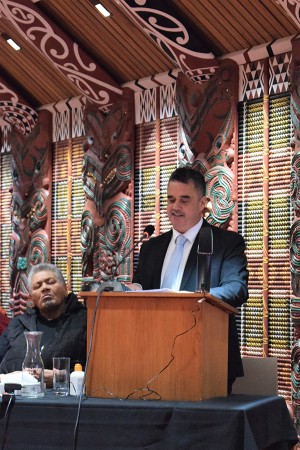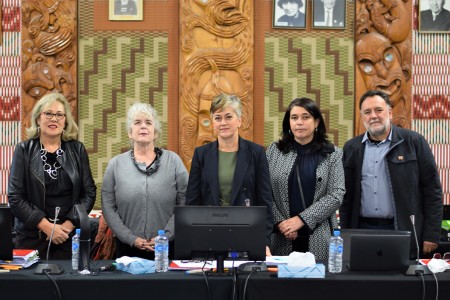What witnesses said about atua narratives being reconstructed over time
- “Much of the discourse around the roles and respect for Wahine Māori prior to European contact have been obscured through early white anthropological perspectives who either misperceived, deliberately misrepresented, or simply erased altogether the presence and importance of Wahine Māori. As scholar Aroha Yates Smith has noted: These early ethnographers predominantly focused upon Atua Tāne – male gods – and ignored a multitude of Atua Wāhine, resulting in a male biased perception of our pantheon. Anthropologist Elsdon Best – who provided much of the written material upon which we would come to base our understandings of precolonial Māori – literally referred to our most sacred center thus: “The house of misfortune, of ominous inferiority, is represented by this world, by the earth, by the female sex, and by the female organ not generations, which holds dread powers of destruction and pollution.” The colonial lens is indeed a misogynistic lens, in addition to being a white supremacist lens, and so the policies and legislation which stemmed from this view naturally placed Wahine Māori within crosshairs which continue to shape our destinies, and that of our children, for years to come.” (Mereana Pitman, doc A18(a), p 4)(external link)
- “Perhaps we do not know about the nature of the goddesses because no female rangatira, or chiefs, reported their stories to early ethnographers in as much detail as those reported by Smith and Best, and almost certainly women’s stories and perspectives were not so eagerly sought after by those early ethnographers.” (Ella Henry, doc A63, pp 7-8)(external link)
- “There are other atua whaea whose names vary depending on who is giving the kōrero, and where the kaikōrero is from. Whaea or kuia are part of the narratives of acts by Māori atua, although their names are rarely stated in the general English documents. An example is the kōrero for Tāwhaki, and his receiving ngā kete mātauranga (‘baskets of knowledge’) from a kuia. While the kōrero tells what was in the kete, it doesn’t tell us how the [mātauranga] got into the kete. Was it placed there by the kuia, or by some other person? It is my opinion that, in the recording of these kinds of kōrero by early researchers, the factor of a female having or carrying mātauranga was deliberately ignored. This would have been on the basis that only males held knowledge and the capacity to educate others. This, for Māori, is far from the reality, but it is a position which I believe is deeply entrenched in the western culture.” (Patricia Tauroa, doc A60, p 7)(external link)
- “It seems a simple enough suggestion that [‘Tihei Mauri Ora’] the words of Hineahuone are words that are those of Māori women. We should expect to be able to claim the words of our tūpuna whaea and to speak those words. However, this is not necessarily the case. I am aware of Māori woman being told women are not to say those words; they are only for men. Colonial hegemony is embedded in all aspects of our experiences as Māori women, to the extent that we are told not to speak the words of our tūpuna wahine.” (Leonie Pihama, doc A19, p 3)(external link)
- “The choice of language used by [Elsdon] Best illustrates his own thinking in regard to Māori women. … In regard to atua, female atua are, on the whole, described as ‘assistants’ to male atua.” (Leonie Pihama, doc A19, p 31)(external link)
- “The view held by [Elsdon] Best also appears to be linked to the idea that all children of Papatūānuku and Ranginui were male, and the extension from that in Best's writings is that all things male are more godly than female. The problem with such a position is that it disregards the existence of ātua wāhine. There is a critical question that needs to be explored more fully in future research in this area, which is; if all the children of Ranginui and Papatūānuku were male where did the atua wāhine originate?” (Leonie Pihama, doc A19, pp 32-33)(external link)
- “Examples of the process of diminishing Māori women's roles pervade [Elsdon] Best's work such as his description of Maui's attempt to claim immortality, by entering the vagina of Hine-nui-te-pō, as a ‘contest’ between ‘Light and Darkness’. The ‘Darkness’ being Hine-nui-te-pō, the female element.” (Leonie Pihama, doc A19, p 35-36)(external link)
- “[Berys] Heuer locates her assertion of the inferiority of Māori women within what she describes as the ‘mythological origins’ of Māori women. She outlines the role of Tāne in seeking the female element whilst disregarding the role of atua wāhine in particular Papatūānuku from whom Hineahuone originated. Heuer states that creation stories such as this act as indicators of male superiority.” (Leonie Pihama, doc A19, p 40)(external link)
- “[In Berys Heuer’s writing] Māori women are referred to as 'passive recipients', whilst simultaneously being presented as destructive forces.” (Leonie Pihama, doc A19, p 40)(external link)
- “The imposition of Christianity that ignores and/or demonises the atua wāhine was instrumental in relegating wahine to an inferior status. The esoteric arts were reserved exclusively for men. The sacred knowledges, ceremonies and whare wananga of the whare tangata have been denied and ignored. Today there is rarely a female counterpart to karakia proceedings, furthering imbalance.” (Ngahuia Murphy, doc A67, pp 4-5)(external link)
- “The sacred roles of wahine in restoring balance in times of transgression have been forgotten. Women’s ritual knowledges have been deliberately censored, erased and denied as wahine have been reframed as ‘profane’, ‘inferior’ and spiritually polluting by colonial ethnographers.” (Ngahuia Murphy, doc A67, p 5)(external link)
- “Evidence from karakia, waiata, korero, moteatea and other oral accounts from tribal authorities highlight the presence of atua wāhine as critical to understanding Māori worldviews. [However,] Pākehā men interpreted Māori society (from their Pākehā and predominantly Christian worldview) and rendered invisible the role of the women and mātauranga-ā-wāhine. The whakapapa of the Atua wāhine (or divine feminine) and mātauranga-ā-wāhine has therefore remained hidden in the academic writings of contemporary mātauranga Māori.” (Kayreen Tapuke, doc A94, p 8)(external link)
- “The rejuvenating cyclic nature of the links between Papatūānuku, and her children were disrupted, and the people likewise were unable to cloak themselves in the weave of their connection with their tīpuna (ancestors) and their atua (spiritual guardians). Knowledge was lost, and/or worse, rewritten and retold through a colonised lens underpinned by Christian ideologies. Our Māori herstories became transmitted through western lenses and paradigms – that then became Māori mythology and history.” (Te Ringahuia Hata, doc A30, p 9(external link))
- “Colonial gender rationalities actively oppressed the identity, authority and voice of women. Feminist genealogy once traced our origins of wahine Māori from nga atua wahine Māori, a method of whakapapa you will hardly hear these days.” (Te Ringahuia Hata, doc A30(b), p 7)(external link)
- “The evidence is widely spoken to that Atua Wāhine were less represented in translations of Māori lore / history written by the likes of Elsdon Best, and Herries Beattie in Te Wai Pounamu. Whether by design or not, Atua Wāhine whakapapa has been infiltrated by colonial and Christian discourses, which has all but extinguished them from existence.” (Aroha Louise Rickus, doc A140, p 6)(external link)
- “In these early publications the notion of female stars and the roles of atua wahine was somewhat dismissed. Important subjects like sex and sexuality, roles of female deity and their impact, the worship of the sun, moon and stars and the role of atua wahine in informing and influencing the community was often not recorded. Combined with the patriarchal nature of Christianity that took hold of Māori society during this era, all impacted on the traditional understanding of atua wahine who are personified in the stars.” (Rangi Mātāmua, doc A86, p 12)(external link)

Professor Rangi Mātāmua giving evidence at Te Mānuka Tūtahi Marae, Whakatāne, pictured with Mereana Pitman (left)

Mana Wāhine inquiry panel inside Terenga Parāoa Marae, Whangārei. From left: Professor Linda Tuhiwai Smith, Dr Robyn Anderson, Judge Sarah Reeves, Kim Ngarimu, Dr Ruakere Hond